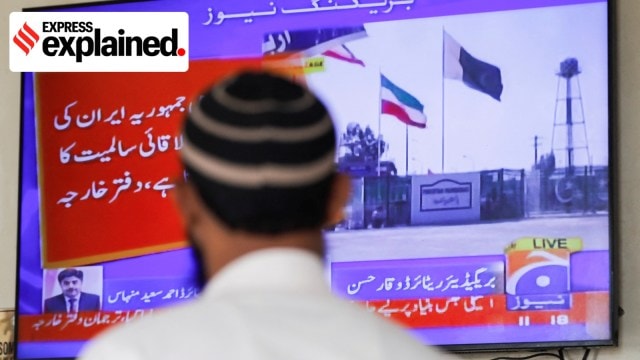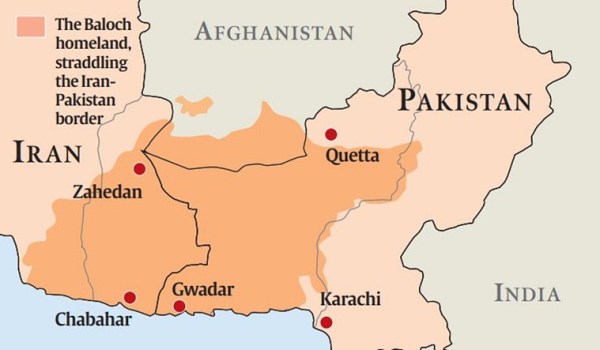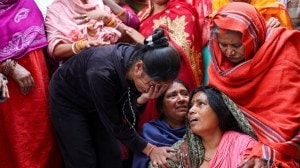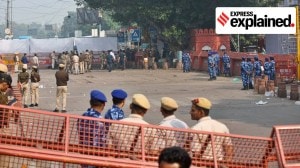Explained: Iran, Pakistan, and the Baloch militancy
Iran and Pakistan have attacked militant bases in each other's territory, but also reaffirmed their commitment to good neighbourly ties. The countries have a history of tensions and cooperation, and a common problem of Baloch insurgency, but in the context of the Middle East conflict, their actions mark a dangerous escalation.
 A man looks at a television screen after the Pakistani foreign ministry said the country conducted strikes inside Iran targeting separatist militants, two days after Tehran said it attacked Israel-linked militant bases inside Pakistani territory, in Karachi, Pakistan January 18, 2024. (Photo: REUTERS/Akhtar Soomro)
A man looks at a television screen after the Pakistani foreign ministry said the country conducted strikes inside Iran targeting separatist militants, two days after Tehran said it attacked Israel-linked militant bases inside Pakistani territory, in Karachi, Pakistan January 18, 2024. (Photo: REUTERS/Akhtar Soomro)The relationship between Iran and Pakistan has taken serious hits over the last two days. On Tuesday night, Iranian missiles and drones struck two alleged bases of the Jaish al-Adl, an anti-Iran Baloch militant group, in Pakistan’s Balochistan province.
Pakistan reacted strongly to the “blatant breach” of its sovereignty, recalled its envoy to Tehran, said the Iranian ambassador (who is now in Iran) “may not return”, and then, early on Thursday, carried out its own cross-border missile strikes on alleged terrorist sanctuaries in Iran.
 Map showing Baloch areas in Pakistan and Iran.
Map showing Baloch areas in Pakistan and Iran.
Iran has summoned a senior Pakistani diplomat in response, and will hold large-scale military exercises near its eastern borders, Al Jazeera reported. Both countries have claimed civilian casualties in attacks by the other side.
Relationship since 1979
Before the 1979 Islamic Revolution in Iran, both countries were firmly allied to the United States and had, in 1955, joined the Baghdad Pact, later known as the Central Treaty Organization (CENTO), a military alliance modelled on NATO.
Iran provided material and weapons support to Pakistan during its 1965 and 1971 wars against India. After the liberation of Bangladesh, the Shah of Iran famously said that he would not tolerate “further disintegration” of Pakistan.
When Ayatollah Khomeini’s ultra-conservative Shiite regime took power in Iran, Sunni-majority Pakistan was undergoing its own Islamisation under military dictator Gen Zia-ul-Haq — and the two countries found themselves at opposite ends of the sectarian divide.
Geopolitically too, differences began to emerge.
First, as Iran went from being an ally to a sworn enemy of the United States almost overnight, the Americans embraced Pakistan closer. Since 1979, has been a major reason for the Iranian distrust of Pakistan, which increased after 9/11 as Islamabad extended unqualified support to the US “War on Terror”.
Second, Iran’s post-1979 foreign policy focus on exporting the revolution made its Arab neighbours nervous. Each of these oil-rich kingdoms was effectively controlled by a small group of families, not unlike the Shah’s regime in pre-revolution Iran. Pakistan’s continued strategic ties with these Arab kingdoms added rough edges to its relationship with Iran.
Third, Pakistan and Iran ended up on opposite sides in Afghanistan after the withdrawal of Soviet forces. Iran backed the Northern Alliance against the Taliban, a Pakistani creation — and almost entered the war after the hardline Sunni militia massacred Persian-speaking Shia Hazaras and eight Iranian diplomats in Mazar-i-Sharif in 1998.
Attempts at reconciliation
Over the years, the two countries have made attempts to improve their ties.
On a visit to Tehran in November 1995, Prime Minister Benazir Bhutto called Iran “a friend, a neighbour and a brother in Islam”, and expressed regret at the tightening of US sanctions against the country. Benazir’s government also started importing gas from Iran.
The relationship soured after Gen Pervez Musharraf took power in a military coup in October 1999, and did not show signs of improvement until the Pakistan People’s Party returned to power in 2008. Benazir’s husband Asif Ali Zardari, who led the PPP after her assassination and was President from 2008-13, was Shia — and Pakistan’s Sunni Arab allies, especially Saudi Arabia, feared an Iran-led “Shi’ite triangle” in the region, including the government of Nouri al-Maliki in Iraq.
Zardari’s Pakistan increased cooperation with Iran, especially in trade and energy. In 2013, the PPP regime approved the Iran-Pakistan gas pipeline project.
After becoming Prime Minister in June 2013, Nawaz Sharif moved to undo Pakistan’s pro-Iran tilt. He secured major deals with Saudi Arabia, including a $1.5 billion aid package, and strengthened relationships with other Arab allies. The Iran pipeline project remains incomplete.
Common Baloch ‘problem’
The 909-km Iran-Pakistan border, known as the Goldsmith Line, stretches from a tripoint with Afghanistan to the northern Arabian Sea. Roughly 9 million ethnic Baloch live on either side of the line, in the Pakistani province of Balochistan, and the Iranian province of Sistan and Baluchestan. Another 500,000 live in the neighbouring areas of Afghanistan in the north.
The Baloch share cultural, ethnic, linguistic, and religious links that transcend modern borders. They also nurse deeply rooted grievances against both the Pakistani and Iranian states.
In Pakistan, the Baloch are an ethnic minority physically and politically distant from the Punjabi-dominated regime; in Iran, in addition to being an ethnic minority, the majority-Sunni Baloch are also a religious minority who have been persecuted by the state.
The Baloch homeland is rich in natural resources but impoverished. In Iran, 80% of the Baloch population lives under the poverty line. In Pakistan, massive investments in projects such as China’s Belt and Road initiative have not improved their lives.
Baloch nationalism traces its roots to the early decades of the 20th century, when new international borders came to be drawn in the region. Their marginalisation in both countries in subsequent years fuelled several separatist movements for a “Greater Balochistan” nation state.
The insurgents travel back and forth across the porous border after attacking military, and sometimes, civilian targets. Iran’s strikes were in response to terrorist actions by the Sunni Islamist Jaish al-Adl that operates in Iran; the Pakistani response targeted the Baloch Liberation Army and the Baloch Liberation Front, separate groups that have been active in Pakistan.
Notably, the Baloch insurgents in Iran are often organised on Sunni religious lines, whereas the ones in Pakistan are more secular ethno-nationalist organisations. Iran and Pakistan have earlier cooperated to combat the Baloch insurgency. At the same time, the insurgency has been a source of tension, with the two countries accusing each other of harbouring and supporting terrorists.
The view from New Delhi
Over the past few decades, India’s ties with Iran have developed a meaningful dimension. They have cooperated in the energy sector, despite the US sanctions on Iran, and India’s rapidly improving ties with the Americans.
India has been involved in the planning and building of the Chabahar port, intended to allow it to bypass the overland route through Pakistan for trade with Afghanistan and Central Asia. Chabahar directly competes with Pakistan’s China-funded Gwadar port. Pakistan has always viewed India’s relationship with Iran with concern.
On Wednesday, the Ministry of External Affairs described Iran’s strikes in Pakistan as a matter between those countries, but also mentioned India’s “uncompromising position of zero tolerance towards terrorism”, and said India understood “actions that countries take in their self defence”.
Strategic affairs expert and The Indian Express contributing editor C Raja Mohan said: “India has long maintained that Pakistan harbours terrorists. Iran is simply making the same claim.” Raja Mohan recalled that India had a similar justification for the Balakot surgical strikes of 2019. “It is but natural that India will support Iran in this case,” he said.
According to Raja Mohan, Pakistan’s retaliatory strikes were intended to send a message to India as well. “For Pakistan, this is as much a message to India and the Pakistan Taliban as it is to Iran,” he said. “With its quick and strong response, Pakistan hopes to possibly deter India from carrying out cross-border attacks in the future.”
What happens here onward
At the end of the day, neither Pakistan nor Iran is likely to want to escalate the conflict further. Pakistan is bankrupt for all practical purposes. It worries about India, and is dealing with an increasingly violent insurgency on its Afghan border. In many ways, Iran remains its least hostile neighbour.
Iran too has more pressing matters to deal with. It has been backing the Houthi harassment of ships in the Red Sea, supporting the Palestinians in Gaza, and its proxy Hezbollah has been active against Israel along the border with Lebanon.
Sharat Sabharwal, former Indian High Commissioner to Pakistan, said that having made a statement with the strikes, both countries will now look to de-escalate.
Also, Sabharwal said, “For Iran, Israel or the Saudis, or even the US, might be behind the most recent spurt of Jaish al-Adl activity on its soil. This is why Iran seems to have stepped up its attack on militants beyond the standard infantry and artillery operations, which have happened in the past.”
In effect, both the Iranian and Pakistani strikes seem to have been intended as warning shots to deter their enemies from fomenting trouble in their respective territories. The Pakistani statement on Thursday ended by saying: “Iran is a brotherly country and the people of Pakistan have a great respect and affection for the Iranian people. We have always emphasised dialogue and cooperation in confronting common challenges…and will continue to endeavour to find joint solutions.”





- 01
- 02
- 03
- 04
- 05

































